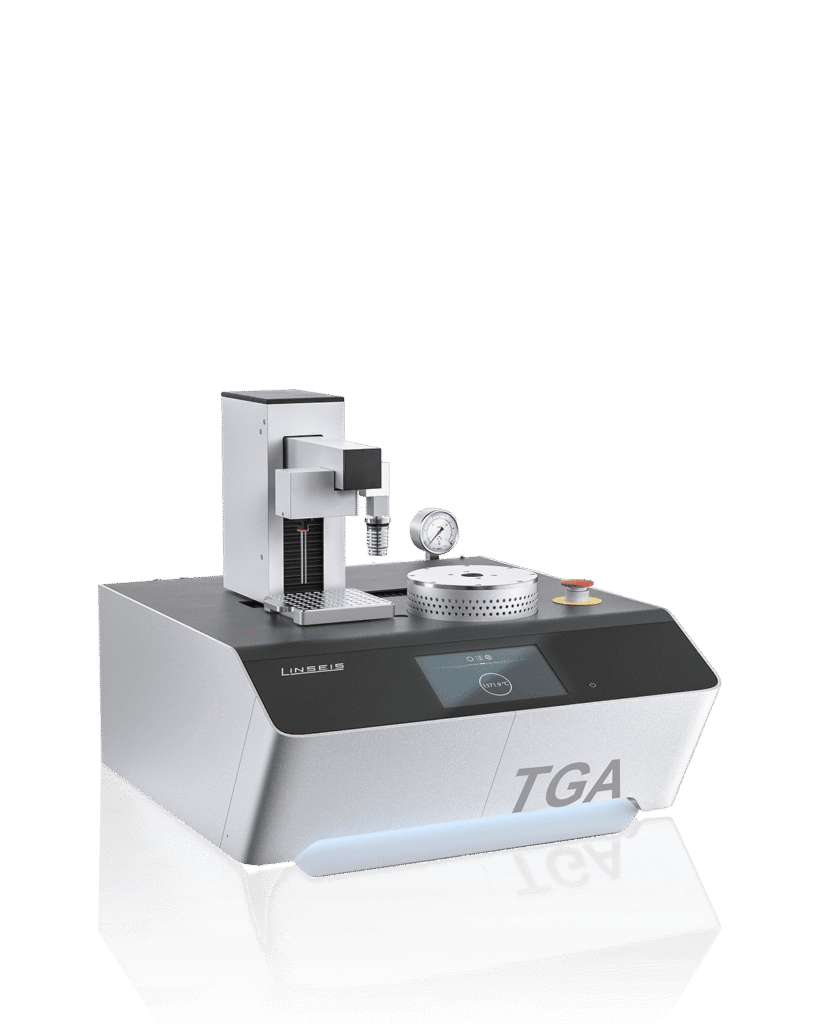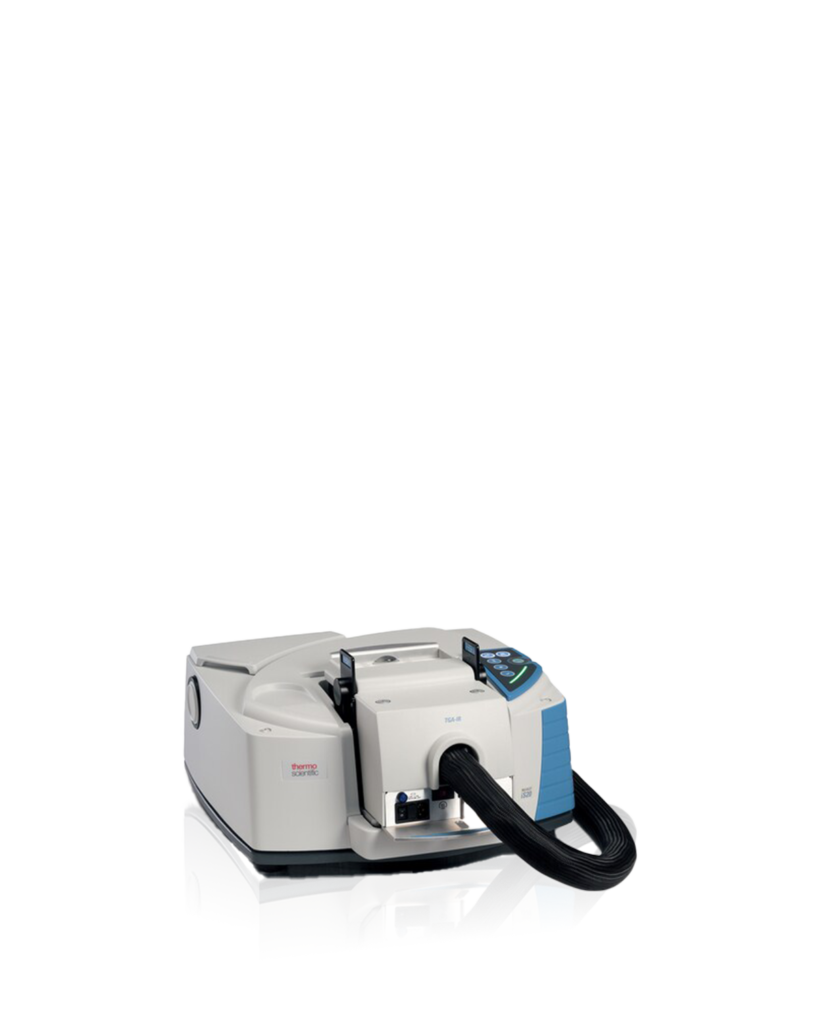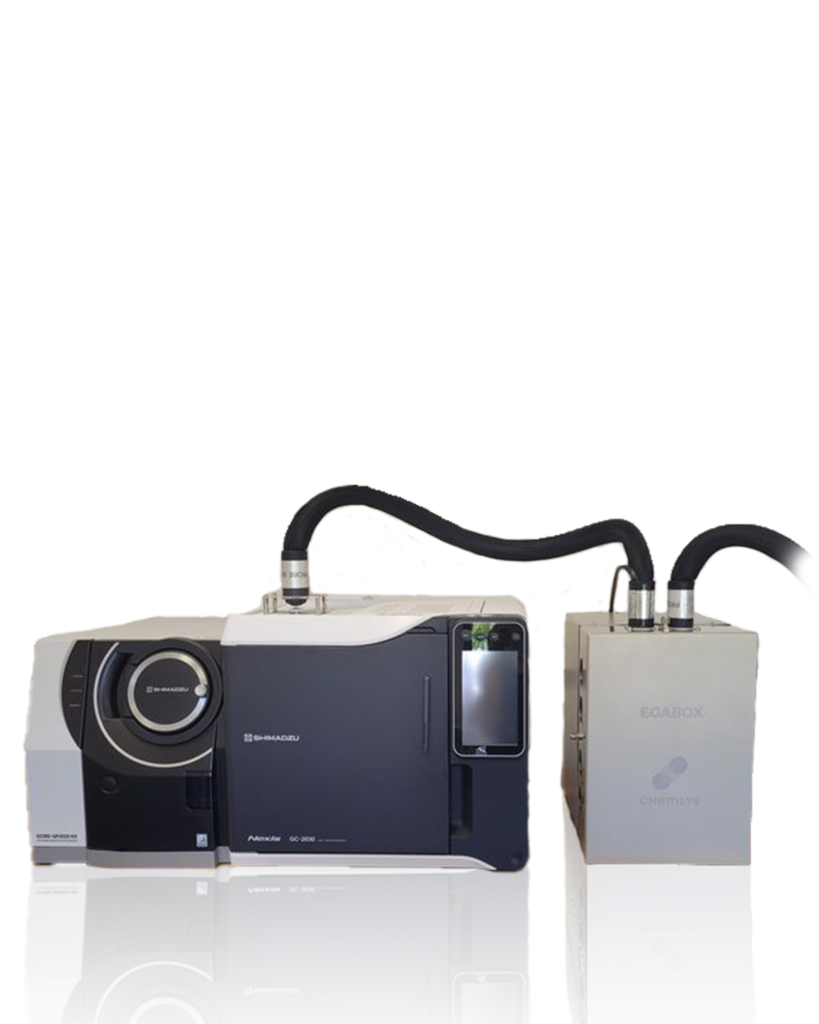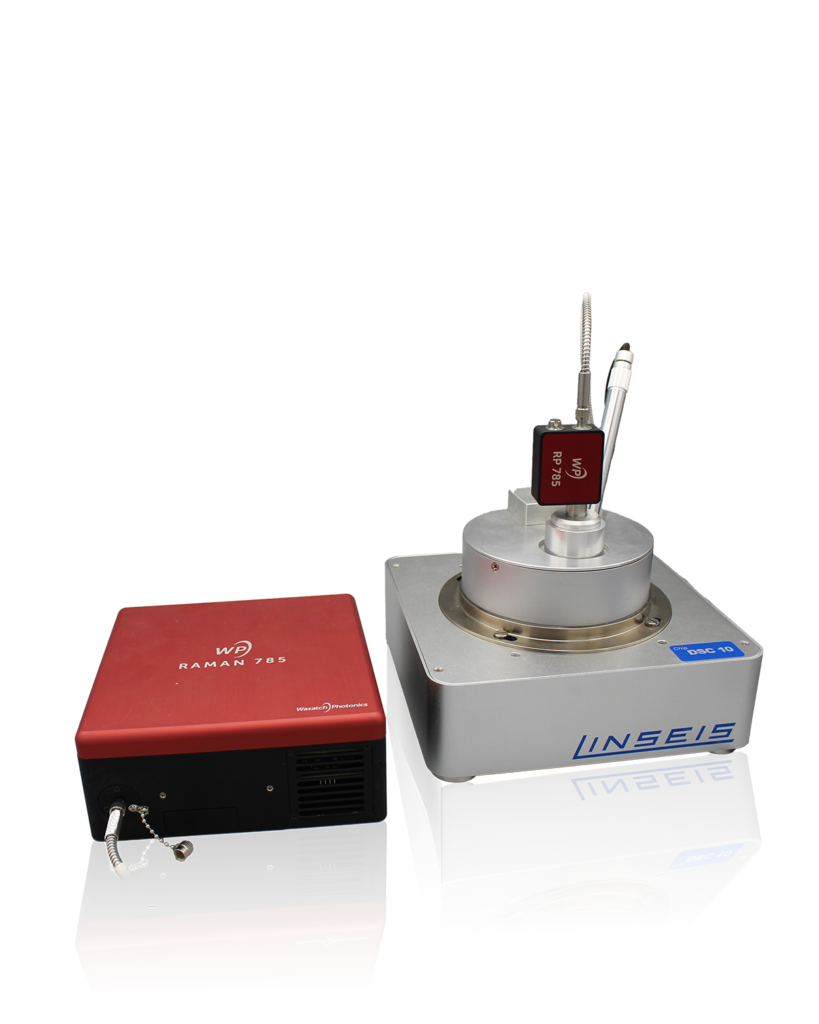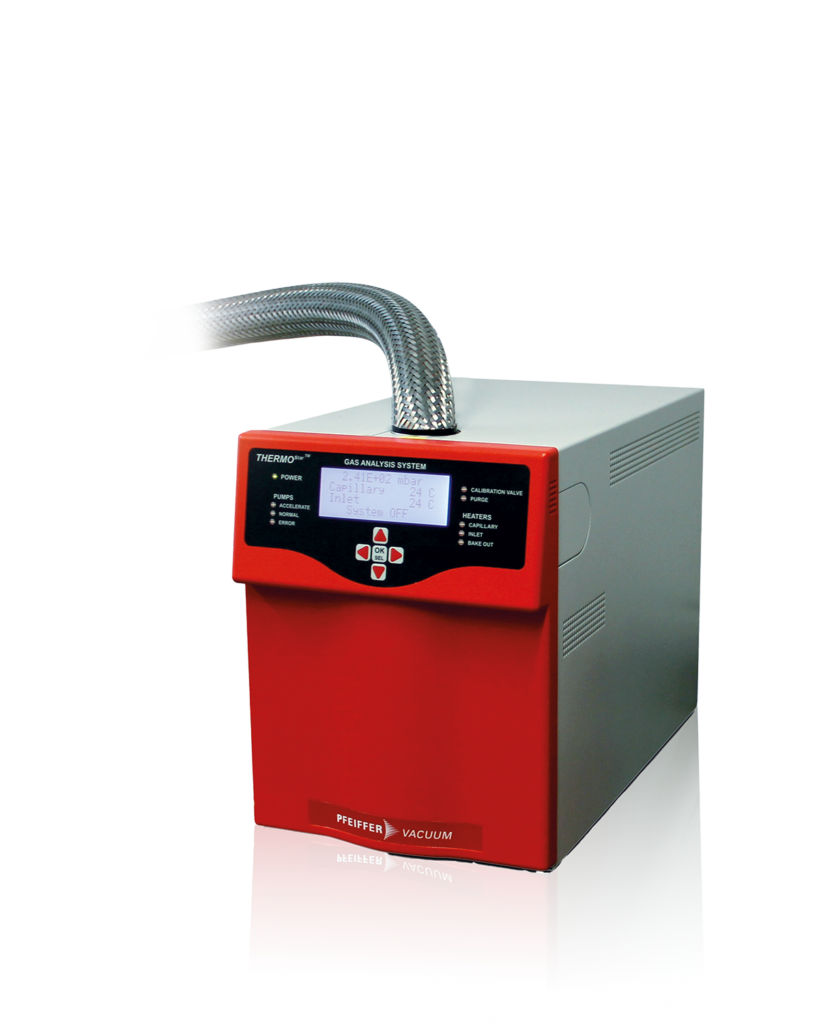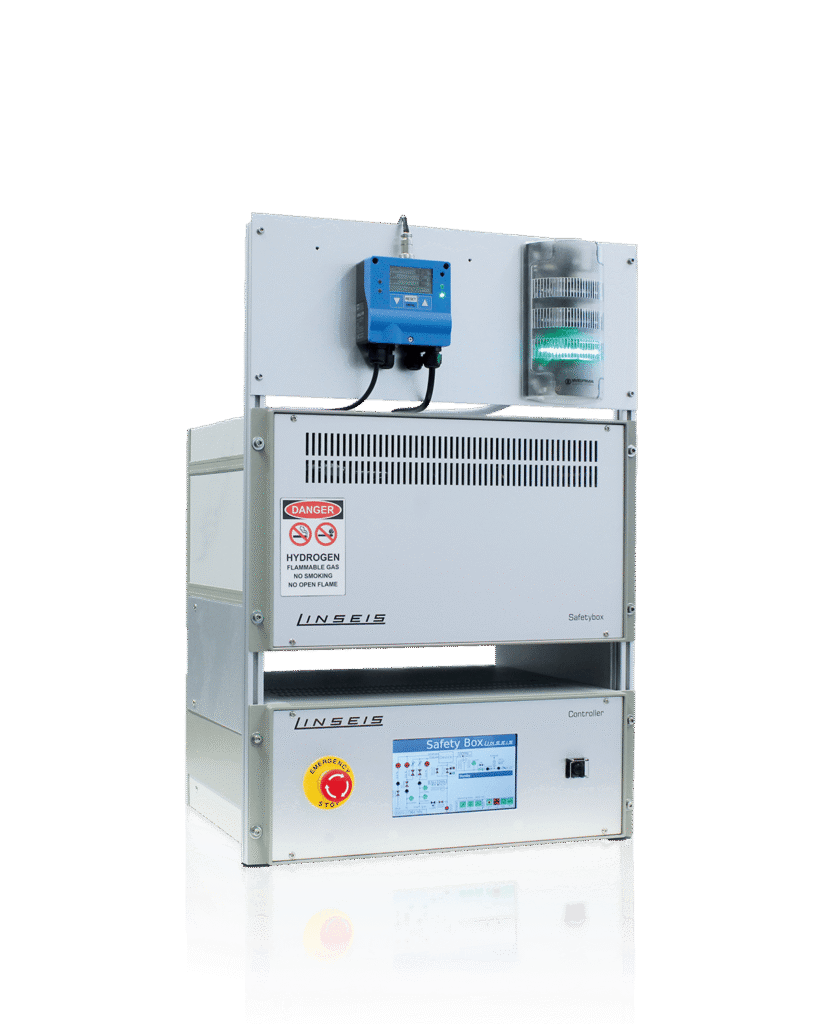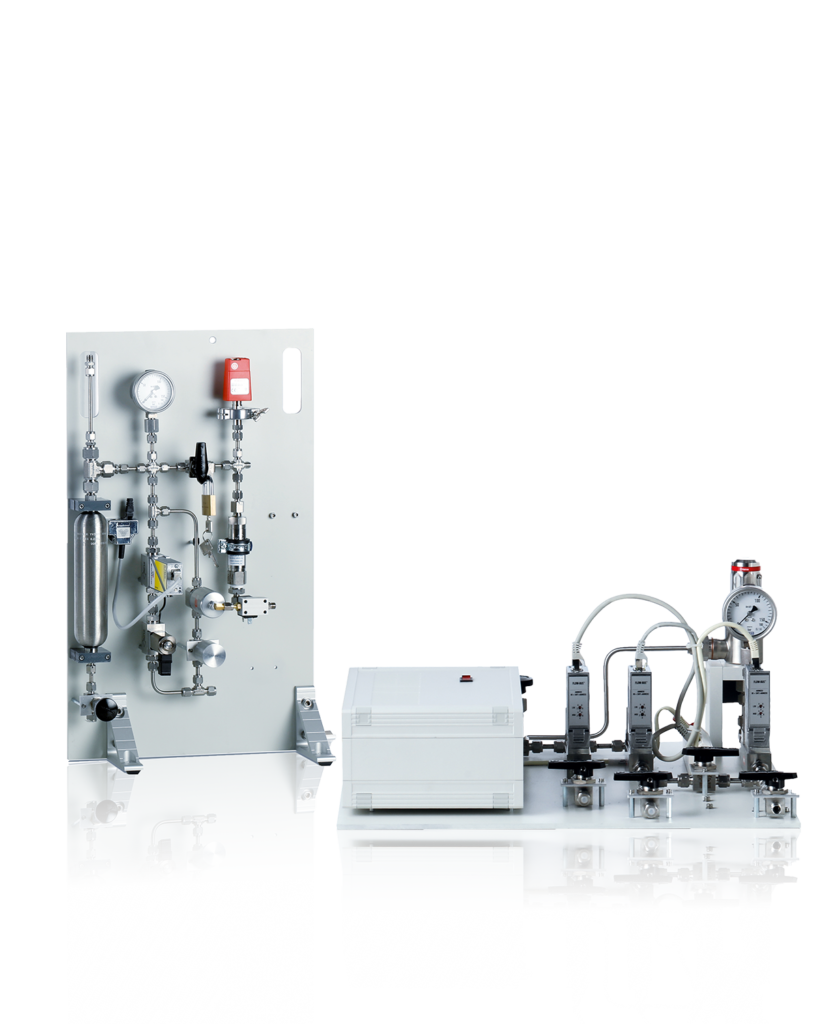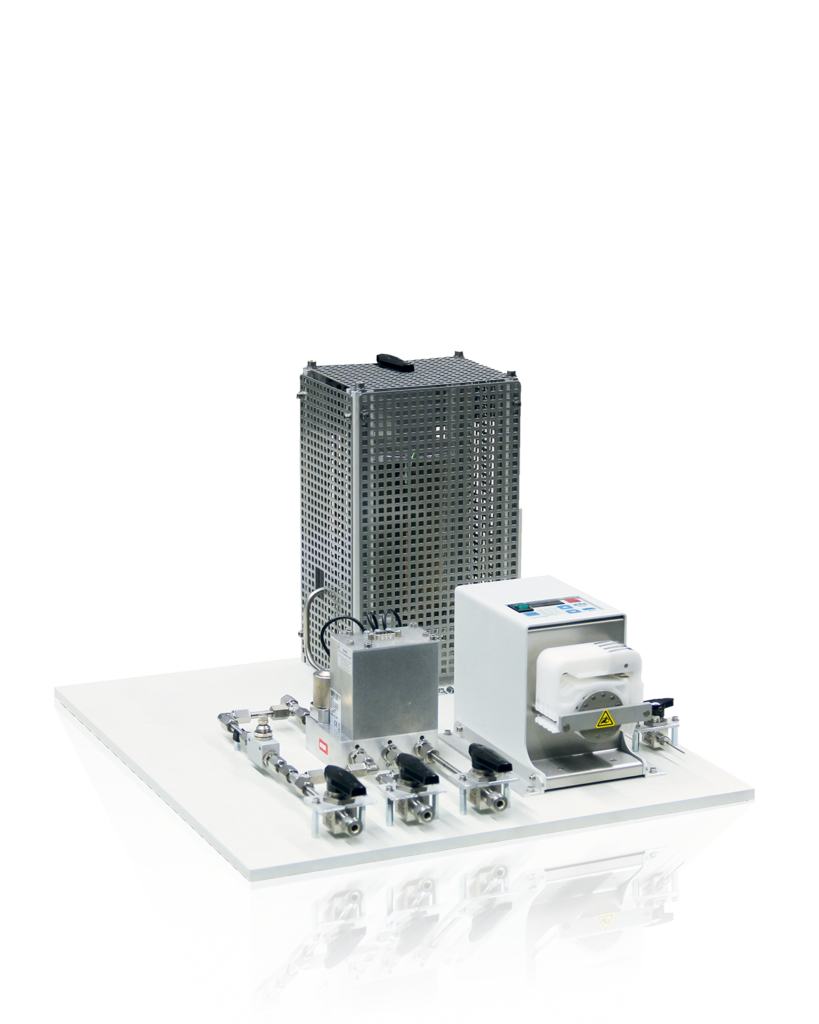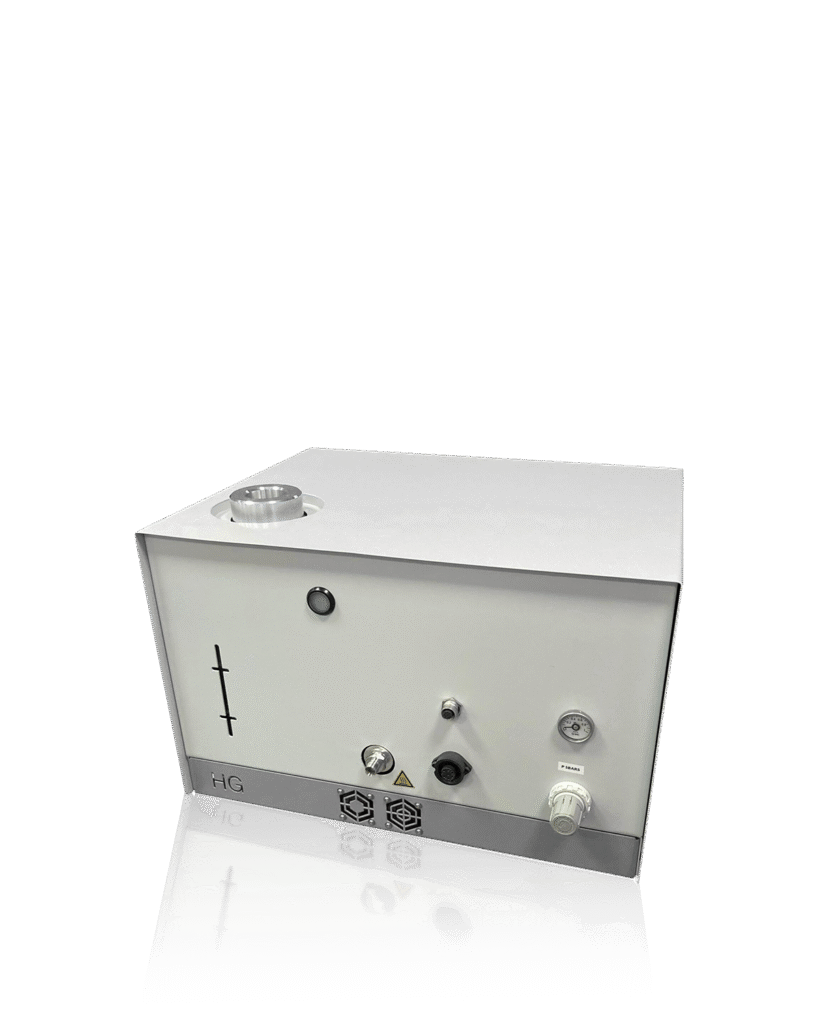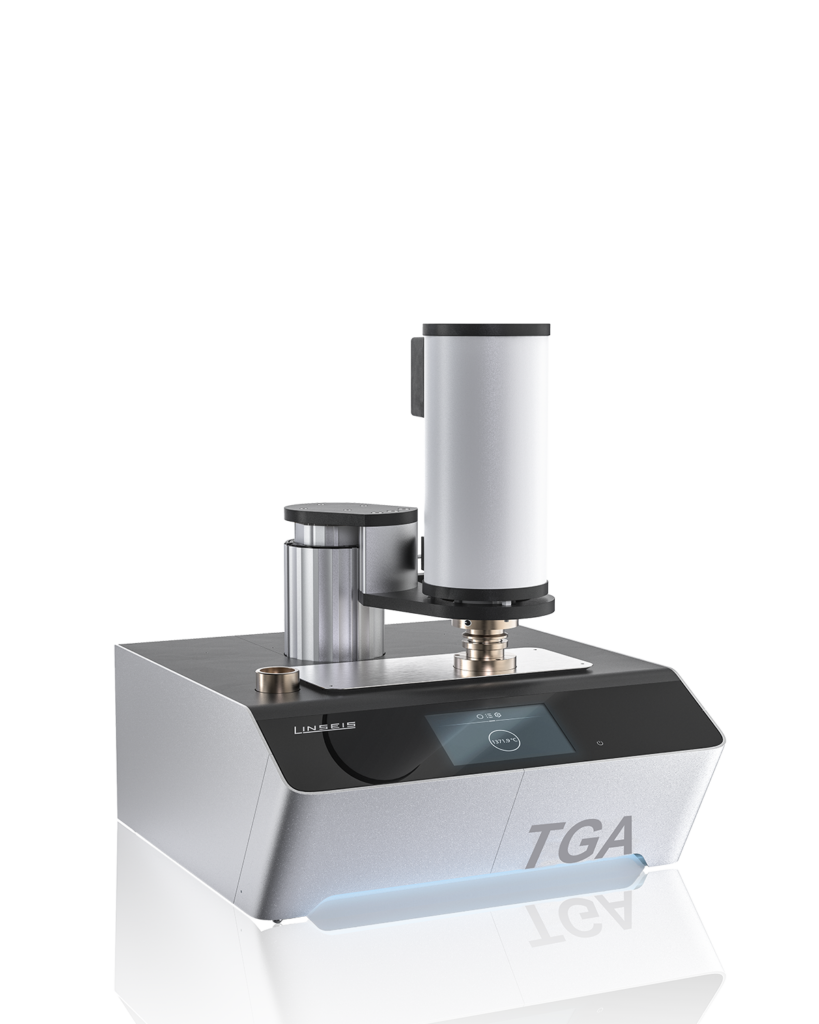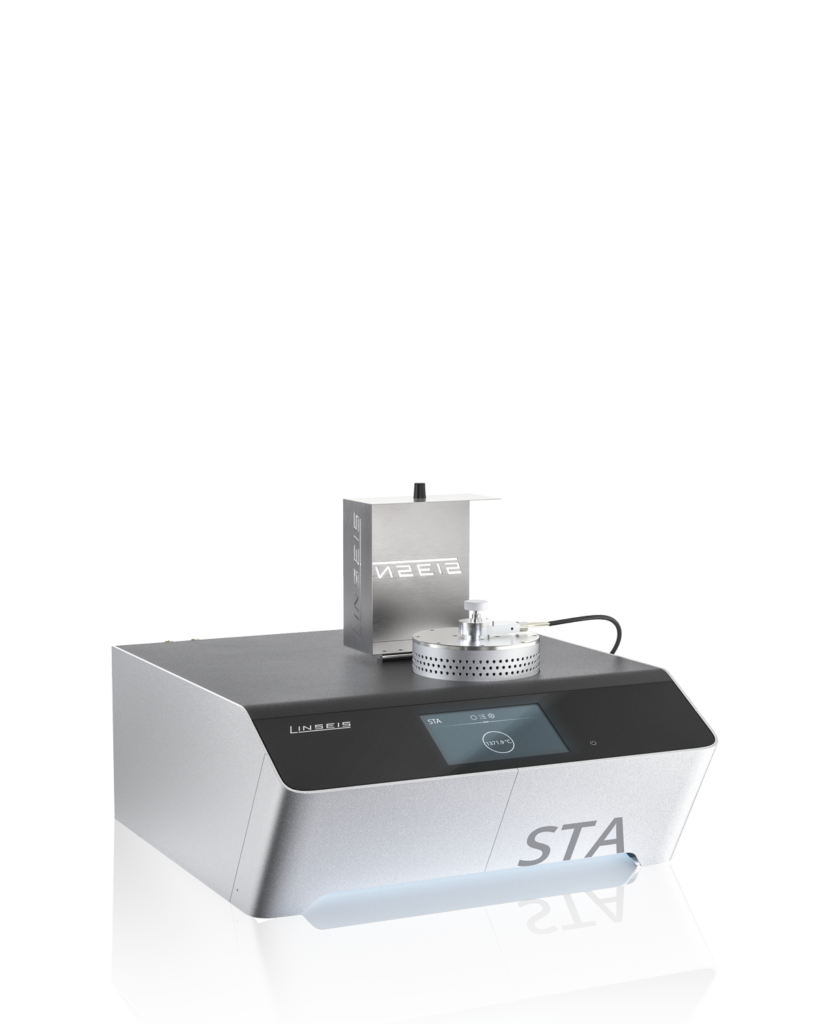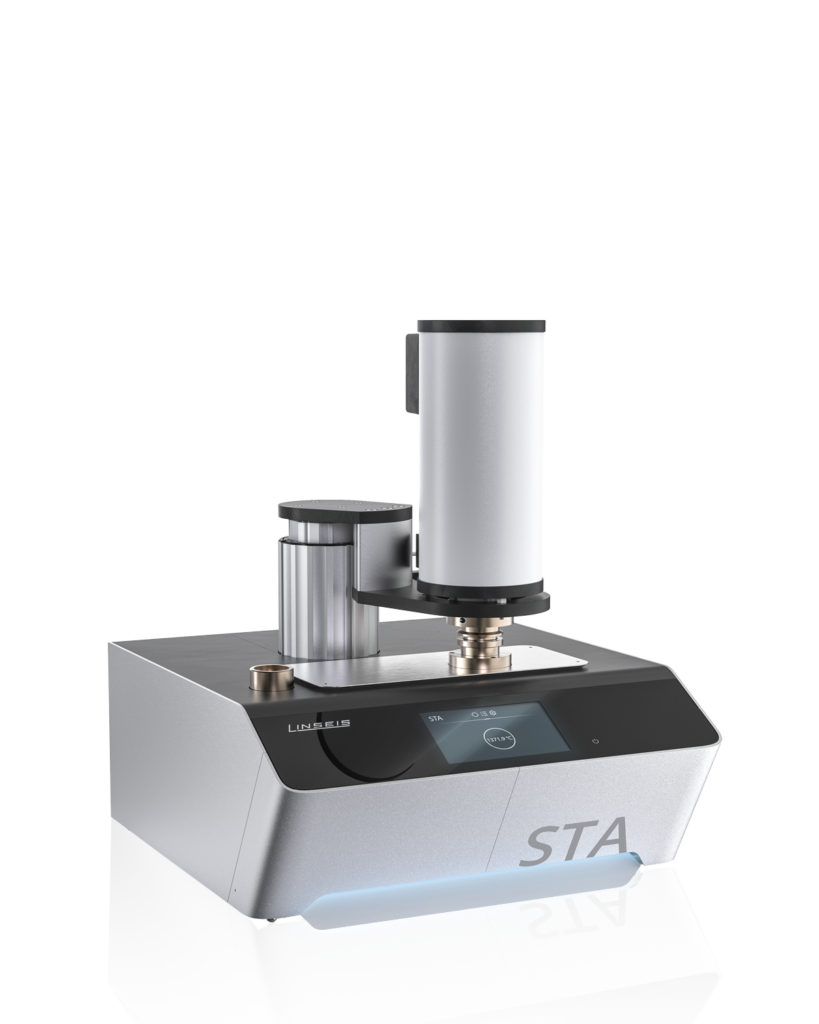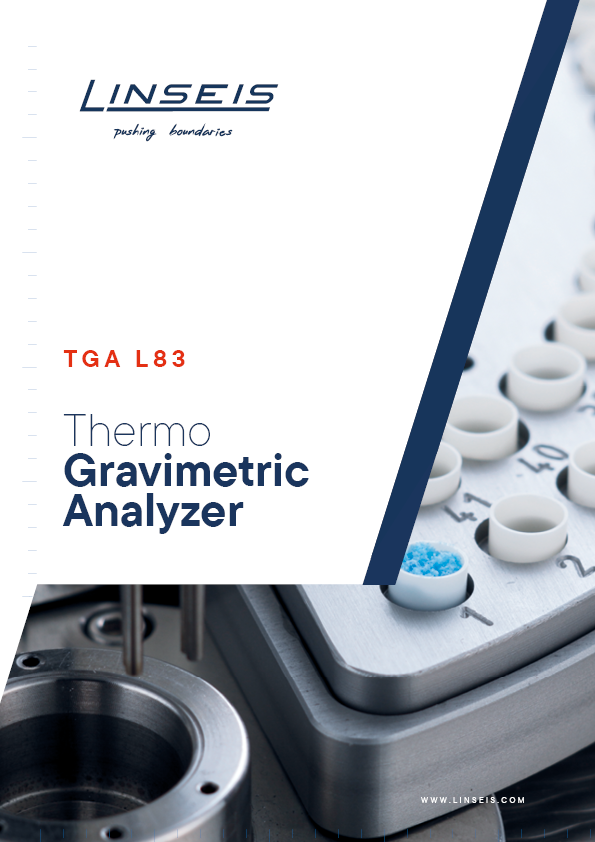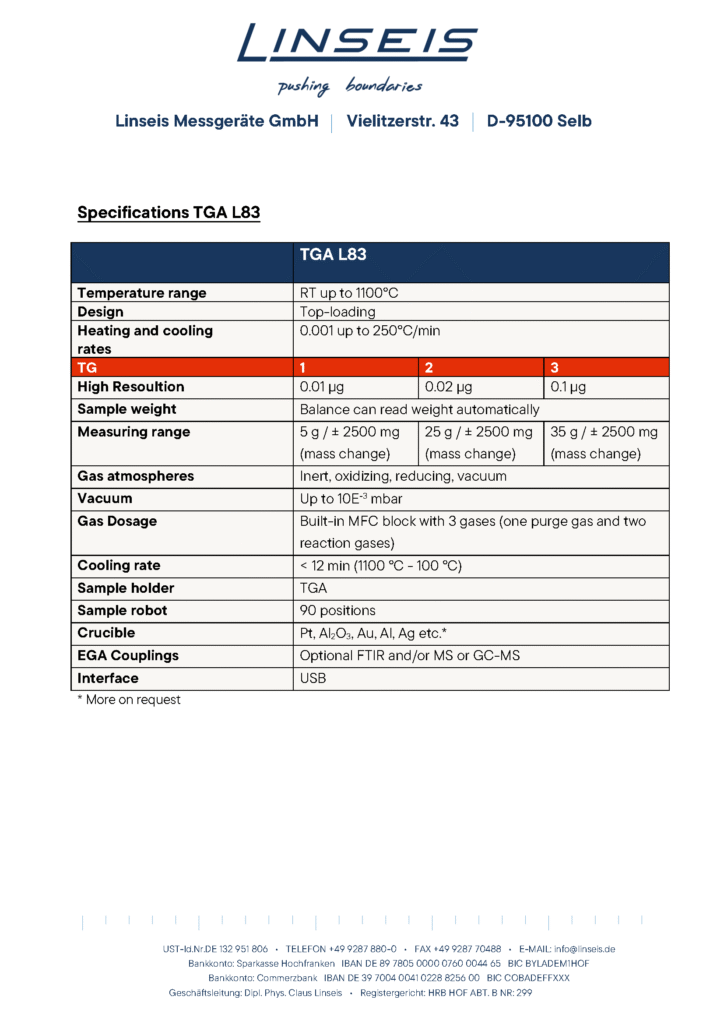TGA L83: High-Precision Thermogravimetric Analysis for Material Characterization
The LINSEIS TGA L83 is a high-performance thermogravimetric analyzer designed for precise mass change measurements under controlled temperature and atmosphere conditions.
Its sub-microgram platinum balance, advanced furnace control, and vertical top-loading design ensure outstanding sensitivity, resolution, and long-term stability.
The TGA L83 supports measurements in inert, oxidizing, reducing, and vacuum atmospheres, with options for Evolved Gas Analysis (EGA), automated gas dosing, and up to 90-position autosampling.
These features make it ideal for material composition analysis, thermal stability studies, and quality control applications in research and industry.
Unique Features

Electronics Upgrade – Precision Through Innovation
The new digital measuring electronics of the LINSEIS TGA L83 are based on the advanced Linseis Digital Balance architecture, offering a substantial boost in performance and reliability.
This next-generation design minimizes signal drift and enhances long-term stability, ensuring the highest precision even during extended measurements.
Key advantages of the new electronic system include:
Minimized drift – guaranteeing consistently precise measurement results over time.
Enhanced resolution – providing unique sub-microgram sensitivity for the most delicate mass changes.
Maximum accuracy – improving the reliability and reproducibility of thermal analysis data.
Excellent reproducibility – delivering consistent results for repeated measurements under identical conditions.
Together, these innovations make the TGA L83 one of the most accurate and stable thermogravimetric analyzers in its class.
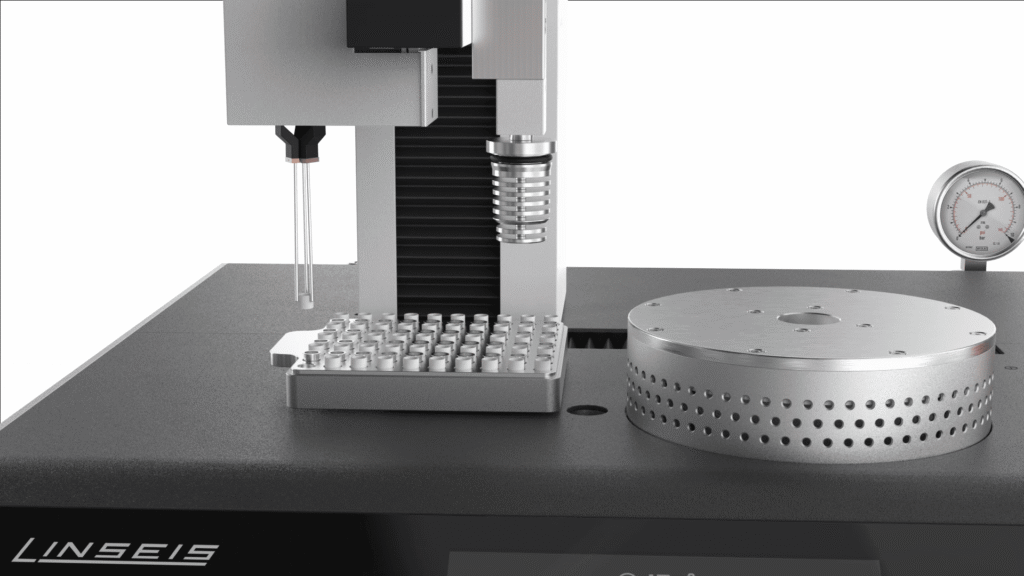
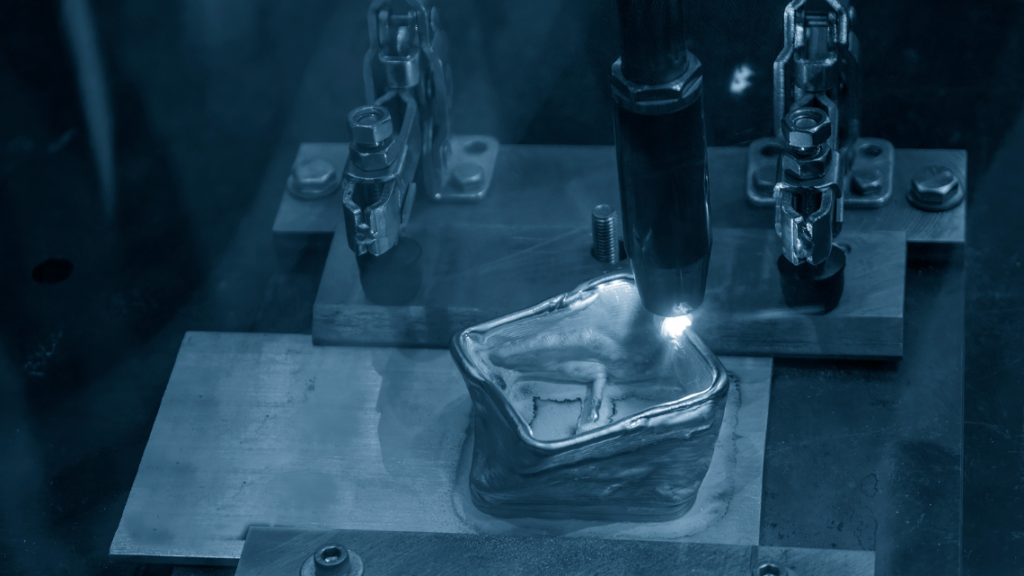
New hardware features
Tri-Couple DTA measuring system
DTA measuring system with three thermocouples for detecting the smallest endothermic and exothermic effects – even with inhomogeneous samples.Jacketed DTA measuring system for corrosive samples
Specially developed for demanding sample environments, the jacketed DTA system offers additional protection against corrosive gases and aggressive decomposition products. It ensures the long-term durability of the sensor system and precise heat flow measurements – even with highly reactive or contaminating substances.Patented “Forced Flow” method
Enables a forced gas flow through your TG or TG-DTA measurement. Up to 100 % of the reaction gas is selectively supplied to the sample.
This innovative method allows scalable measurements for the first time and therefore precise analysis under realistic conditions.
Design improvements
The new device design is characterized by an elegant aluminium housing that is both robust and visually appealing. An LED status bar provides a user-friendly visualization of important information. A touch panel enables intuitive operation and ensures a modern user experience that combines convenience and functionality. The focus of the new design is on ergonomic handling.
Linseis Lab Link
With Linseis Lab Link, we offer an integrated solution for eliminating uncertainties in measurement results. With direct access to our application experts via the software, you receive advice on the correct measurement procedure and how to evaluate the results. This direct communication ensures optimal results and maximizes the efficiency of your measurements for accurate analysis and research and a smooth process flow.
Software improvements
Lex Bus Plug & Play
Our latest hardware interface Lex Bus revolutionizes data communication within our systems.
Lex Bus enables the seamless and efficient integration of new hardware and software tools.Improved oven control
Our new and further optimized oven control system allows even more precise temperature control.
The result: more precise temperature control – exactly according to your wishes and requirements – and therefore better measurement results.New software with user interface
Our communication is now even more focused on your needs:
You are always informed about the current status and receive targeted support whenever it is needed.Process reliability
Our software has been optimized for maximum process security: Your data is protected at all times and can be processed in a fail-safe manner.Error messages and bug fixes
The system automatically detects errors and problems, documents them immediately and fixes them as quickly as possible – for minimal downtime.Automatic updates and new functions
Regular automatic software updates not only improve security, but also continuously bring new functions.Permanent system monitoring
The software permanently monitors all system parameters – for optimum performance at all times.Preventive maintenance and problem detection
Our preventive maintenance approach detects problems and wear at an early stage, before damage occurs – to keep your appliance in top form for the long term.
Automatic evacuation
The appliances have an integrated automatic emptying function that ensures efficient processes and smooth operation.
Evolved Gas Analysis & Gas Safety System
An optional gas analysis with MS, FTIR or GCMS provides valuable additional information. The system supports stand-alone or integrated MFCs for precise gas dosing and can be customized with options such as a heated inlet. A flexible gas safety system enables the safe use of gases such as hydrogen or carbon dioxide.
Highlights

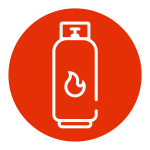

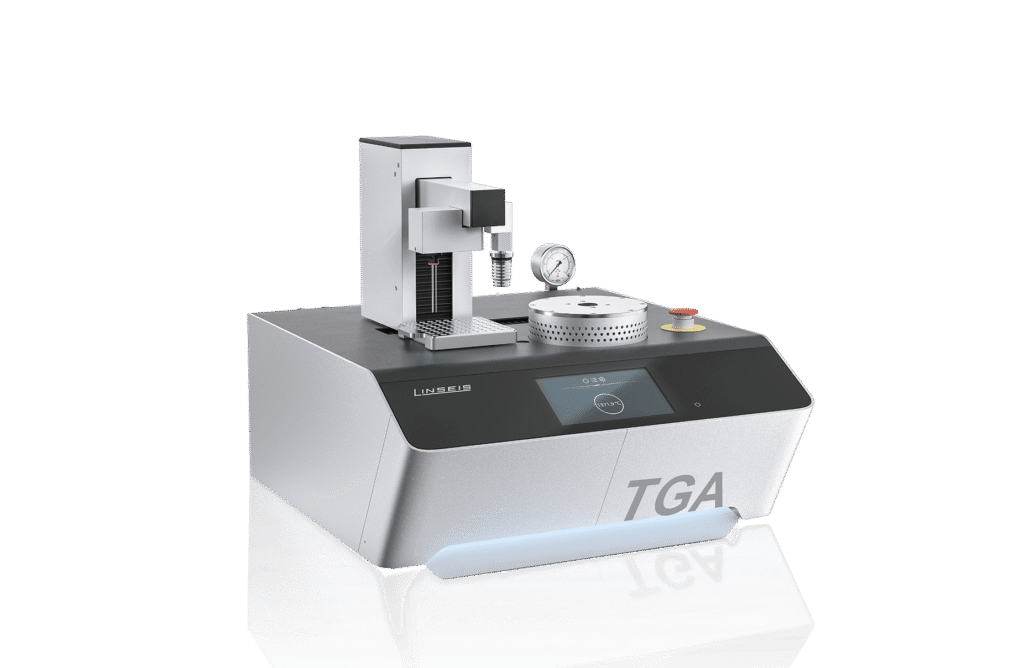
Sample robot
Wide temperature
and pressure range
Versatile application options
Vacuum tight design
Key Features
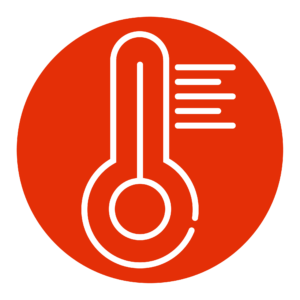
Wide temperature range up to 1100 °C
Controlled heating and cooling rates from 0.001 to 250 °C/min for flexible analysis of a broad range of materials.
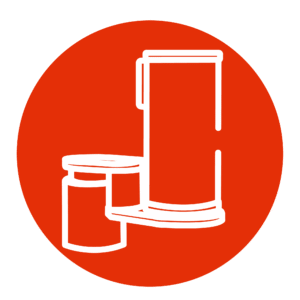
Advanced furnace and thermal management
Innovative top-loading design for excellent measurement stability and easy sample handling.
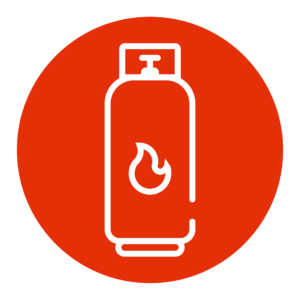
Vacuum and controlled atmosphere
- Supports high vacuum as well as inert, reducing, oxidizing or humidified atmospheres
- Optionally, pressurization with up to 5 bar overpressure is possible
- The analysis of certain corrosive conditions can be realized with appropriate precautions
- A heated capillary can be optionally integrated for residual gas analysis

Integrated LINSEIS platform
The integrated LINSEIS software offers a comprehensive solution that combines hardware and software for maximum process reliability and precision. The standardized platform enables seamless integration of components and devices from external partners – for a particularly robust and reliable overall system.
Questions? We're just a call away!
+1 (609) 223 2070
+49 (0) 9287/880 0
Our service is available Monday to
Thursday from 8 am to 4 pm
and Friday from 8 am to 12 pm.
We are here for you!
Specifications

Measuring range: up to ± 2500 mg

Temperature range: RT up to 1100°C

Up to 90 position auto-sampler
Discover our high-precision TGA – developed for accurate thermal analysis and material characterization:
Heating and cooling rates: 0.001 to 250 K/min
Balance resolution: 0.01 / 0.02 / 0.1 µg
Atmospheres: inert, oxidizing, reducing or vacuum (up to 10⁻³ mbar)
Gas control: integrated MFC block for precise gas dosing
EGA coupling: optional connection to FTIR, MS or GC-MS
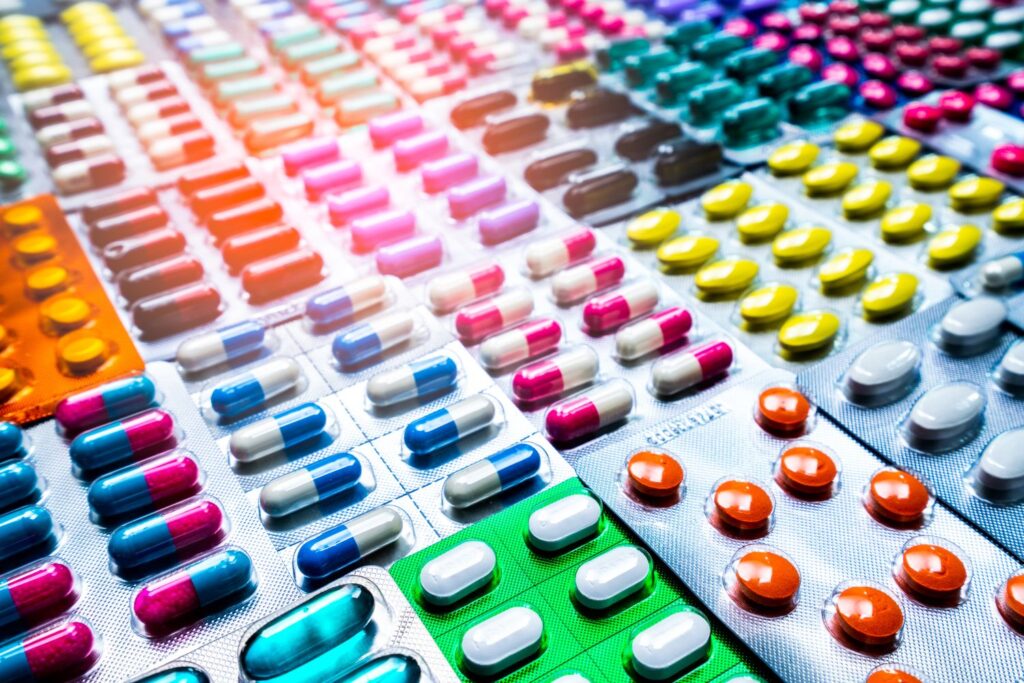
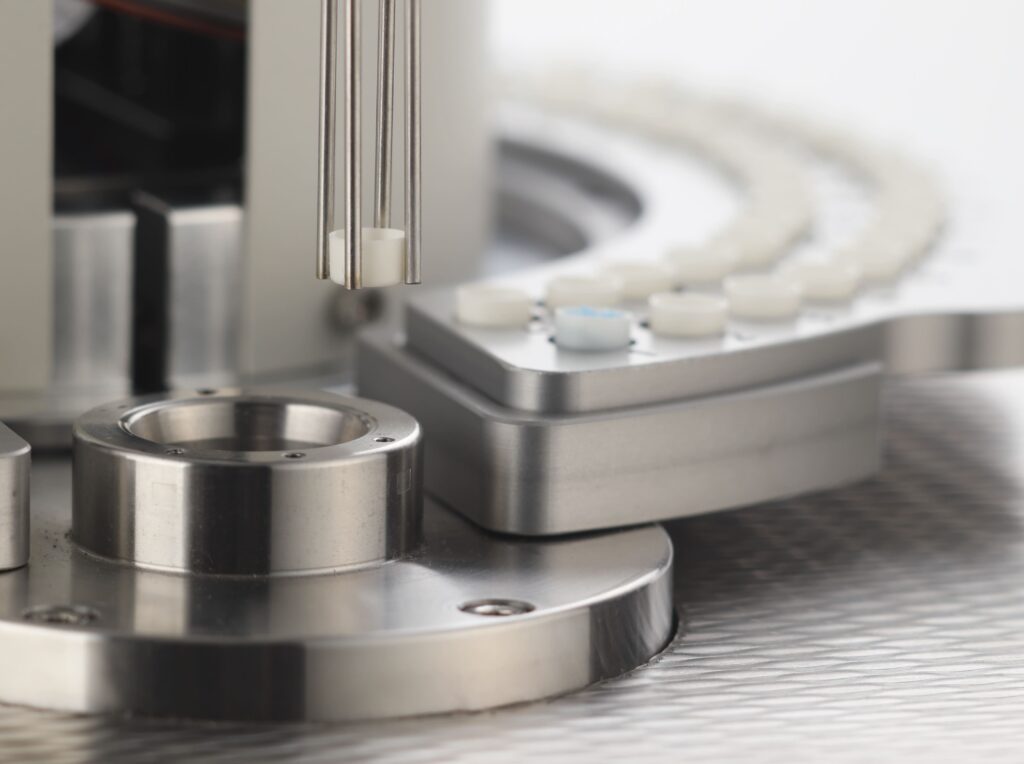
Electronic Upgrade – Unmatched Precision and Stability
The LINSEIS TGA L83 features the latest Linseis Digital Balance architecture, ensuring exceptional precision and long-term measurement stability.
Its advanced electronic system minimizes drift and enhances sub-microgram resolution, providing reliable results even during extended analyses.
Thanks to this next-generation technology, the TGA L83 sets a new benchmark for accuracy, reproducibility, and performance in thermogravimetric analysis.
Recommended Equipment
EGA - Evolved Gas Analysis
Gas Dosing & Gas Safety
Water Vapor & Relative Humidity
Method
Thermogravimetry
Thermogravimetric Analysis (TGA) measures the change in sample mass as a function of temperature or time under a controlled atmosphere.
This method provides fundamental insights into composition, thermal stability, and reaction behavior of materials across a wide range of industries.
During the measurement, the sample is exposed to a precisely defined temperature program in inert, oxidizing, reducing or vacuum conditions.
The LINSEIS TGA L83 records even the smallest mass changes with sub-microgram precision, allowing accurate identification of decomposition, oxidation, reduction, evaporation or desorption processes.
By analyzing these mass losses or gains, TGA enables the quantitative determination of material components, the evaluation of thermal stability, and the characterization of reaction mechanisms.
It is an indispensable technique for the study of polymers, pharmaceuticals, building materials, chemicals, and metals — providing clear and reproducible results for research and quality control alike.
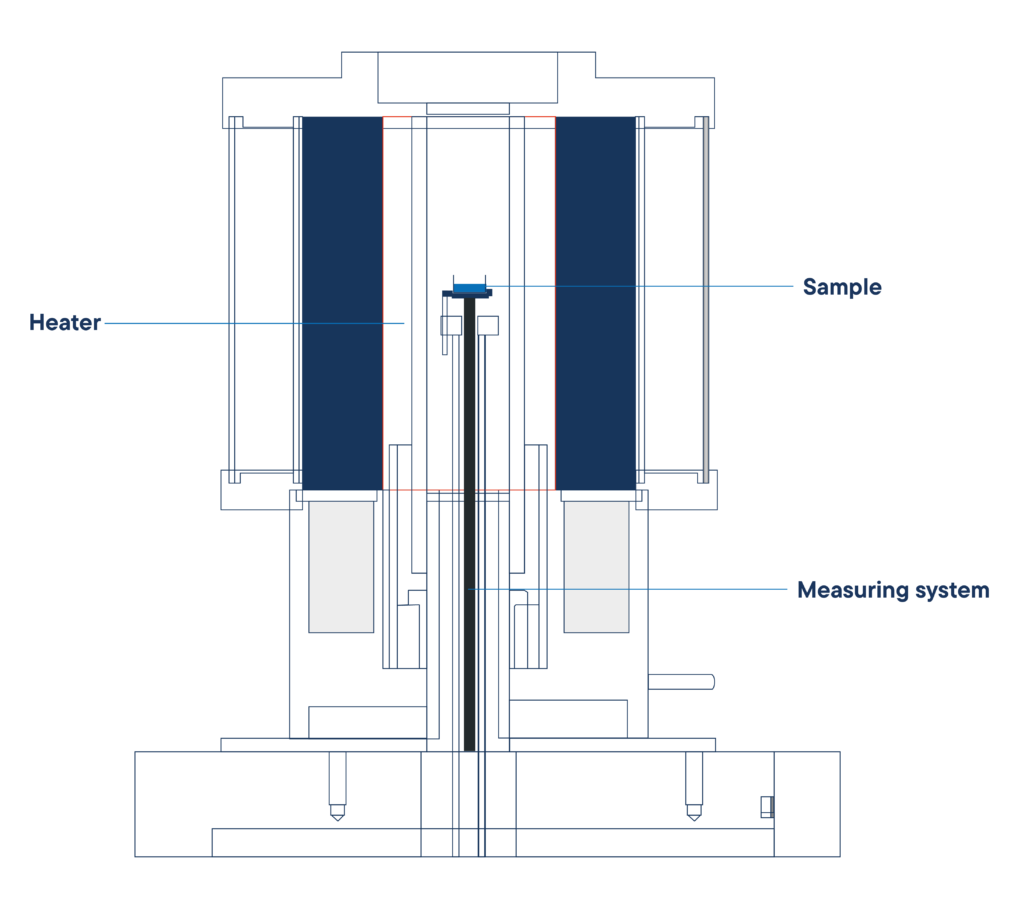
Functional Principle of the TGA L83
The TGA L83 determines changes in sample mass as a function of temperature or time under precisely controlled conditions.
During the measurement, the sample is placed in a crucible and subjected to a defined heating or cooling program in inert, oxidizing, reducing, or vacuum atmospheres.
Throughout the entire temperature cycle, the instrument continuously records the mass change of the sample with sub-microgram precision.
Weight losses or gains caused by decomposition, oxidation, reduction, or evaporation are detected with exceptional sensitivity and resolution.
This measurement principle allows a clear interpretation of thermal reactions and provides valuable information on material composition, stability, and decomposition mechanisms.
With its high-precision balance and advanced furnace control, the LINSEIS TGA L83 delivers reliable and reproducible data for both research and quality control applications.
Measured variables with Thermogravimetry
Possibilities of thermal analysis using thermogravimetry (TG):
A head start with the TGA L83 – high-sensitivity thermogravimetry for diverse materials
Questions? We're just a call away!
+1 (609) 223 2070
+49 (0) 9287/880 0
Our service is available Monday to
Thursday from 8 am to 4 pm
and Friday from 8 am to 12 pm.
We are here for you!
TGA L83 explained – function, use and capabilities
Beam Balance
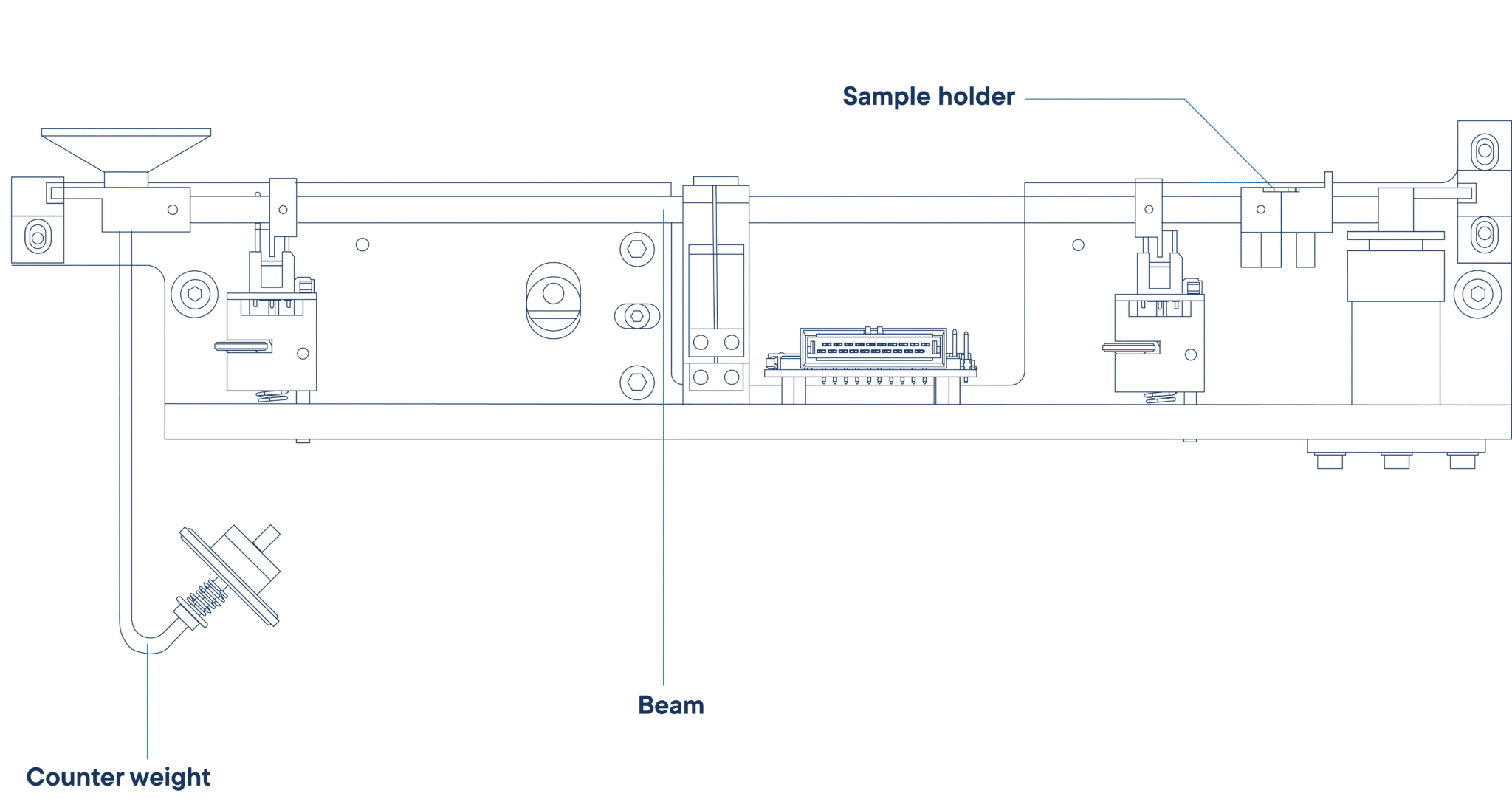
Forced Flow
Forced flow – advantages in the investigation of gas-solid reactions
(patent application pending)
The forced flow principle offers numerous advantages for the analysis of reactions between gas and solid phases:
Controlled conditions
Precise control of the reaction environment for reproducible measurement results.Faster reaction times
Acceleration of slow reactions through continuous gas flow.Better mixing
Even distribution of the reactants for improved reaction kinetics.Continuous analysis
Real-time monitoring and control of the response possible.Scalability
Easily adaptable to different volumes and flow rates – ideal for optimizing production processes.
The forced flow principle is available for both thermogravimetric analysis (TGA) and the differential thermoanalytical method (DTA). This considerably expands the application range of this technology and enables more precise analyses as well as more advanced examination methods in thermal analysis.

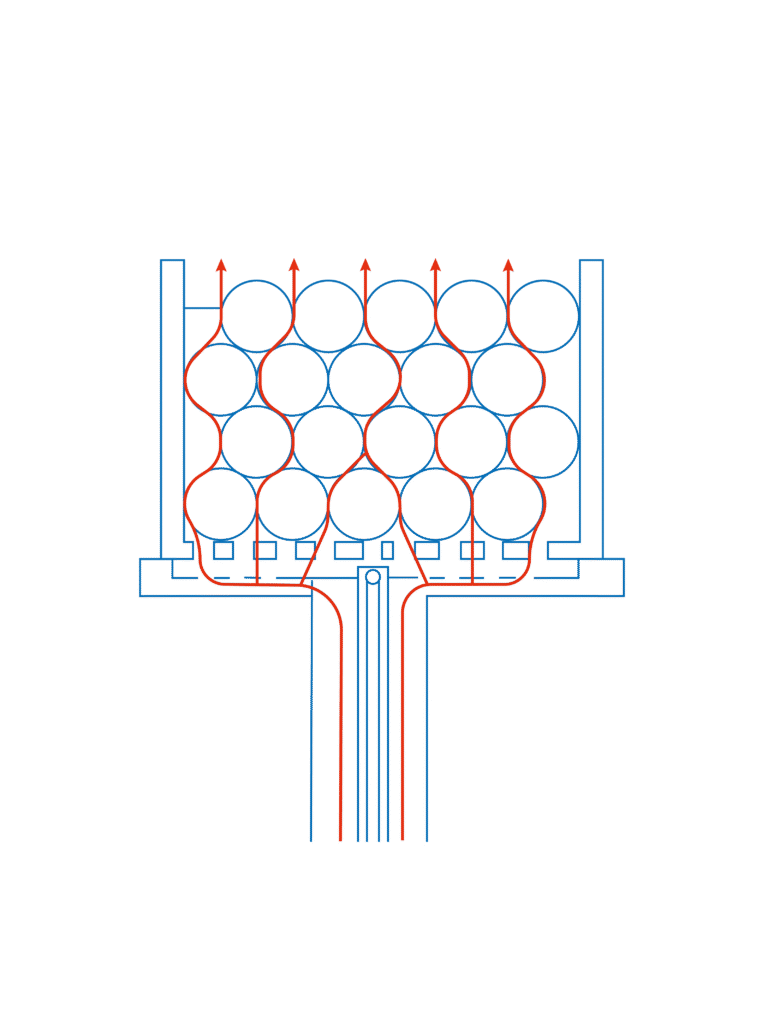
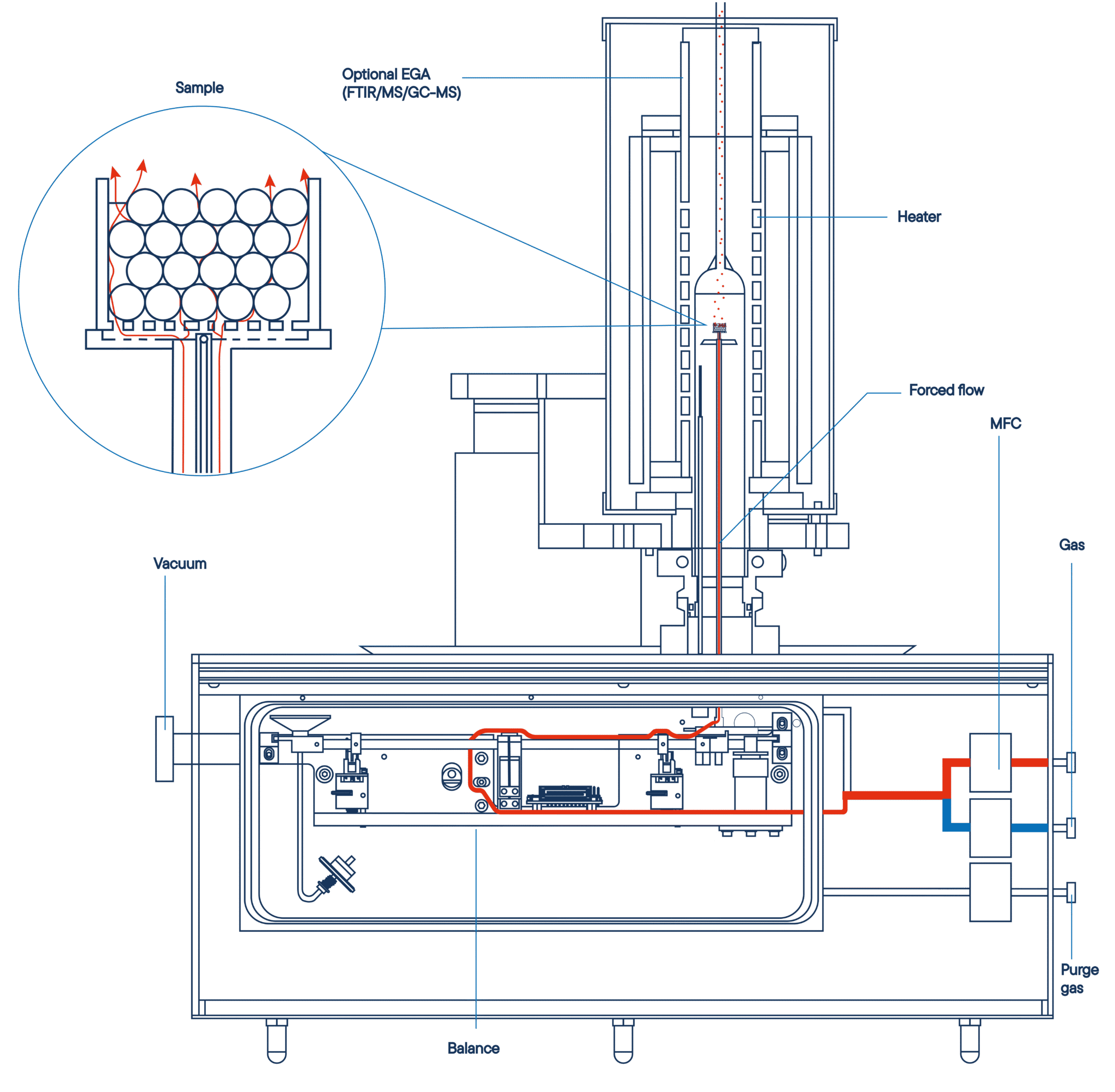
Oxidation rates of copper with different gas supplies
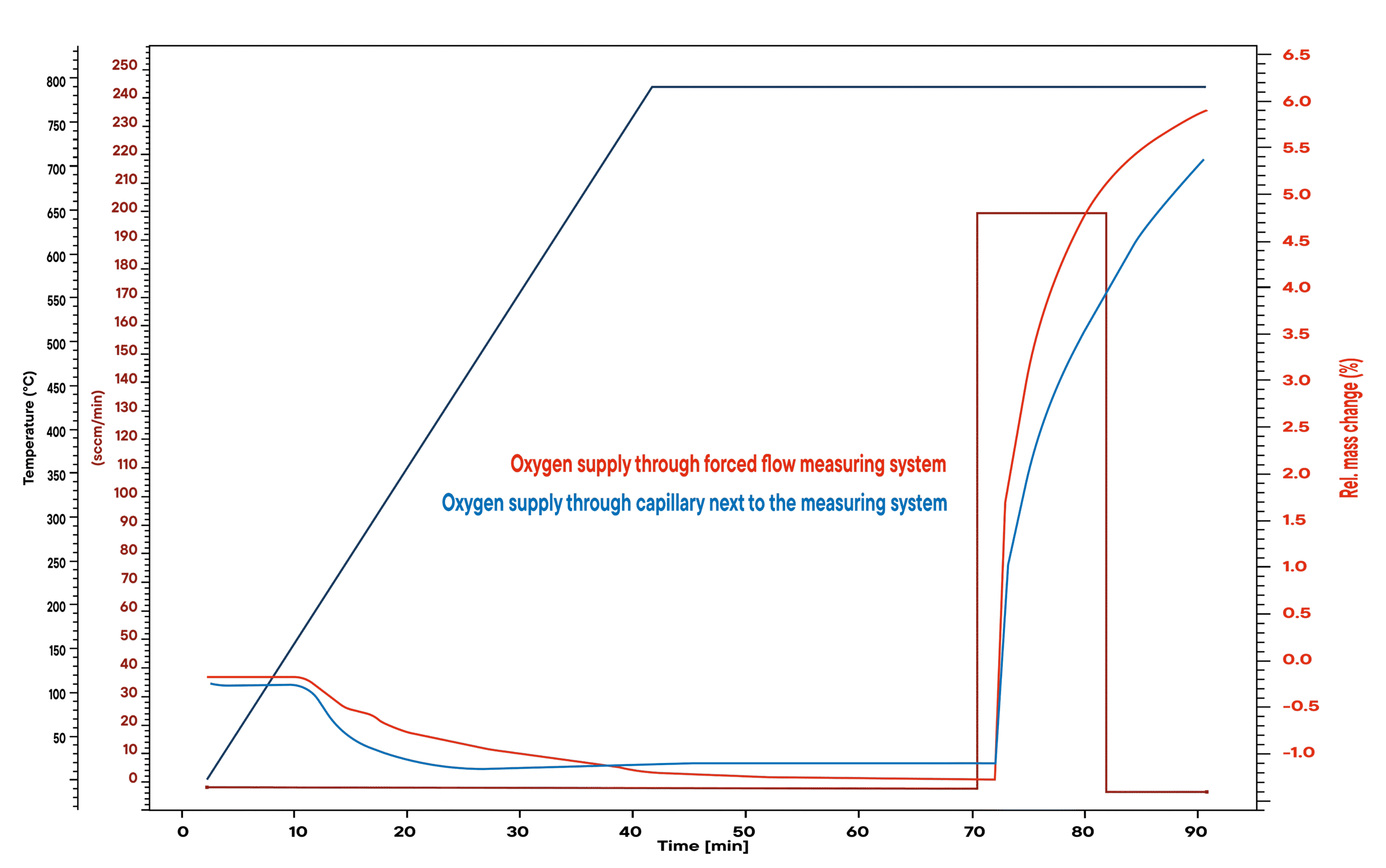
The oxidation of copper produces copper oxide, whereby the reaction rate is highly dependent on the gas supply. The forced flow principle ensures that the oxidizing agent (O₂) is distributed quickly and evenly over the entire sample material right from the start. This allows the reaction to take place much faster than with conventional methods, where the gas only reaches the sample gradually.
The reaction for the formation of copper oxide is:
2Cu + O₂ → 2 CuO
Due to the forced gas flow, the oxygen reacts efficiently with the copper – for accelerated reactions and more precise analyses under realistic conditions.
Which sensors and crucibles are available?
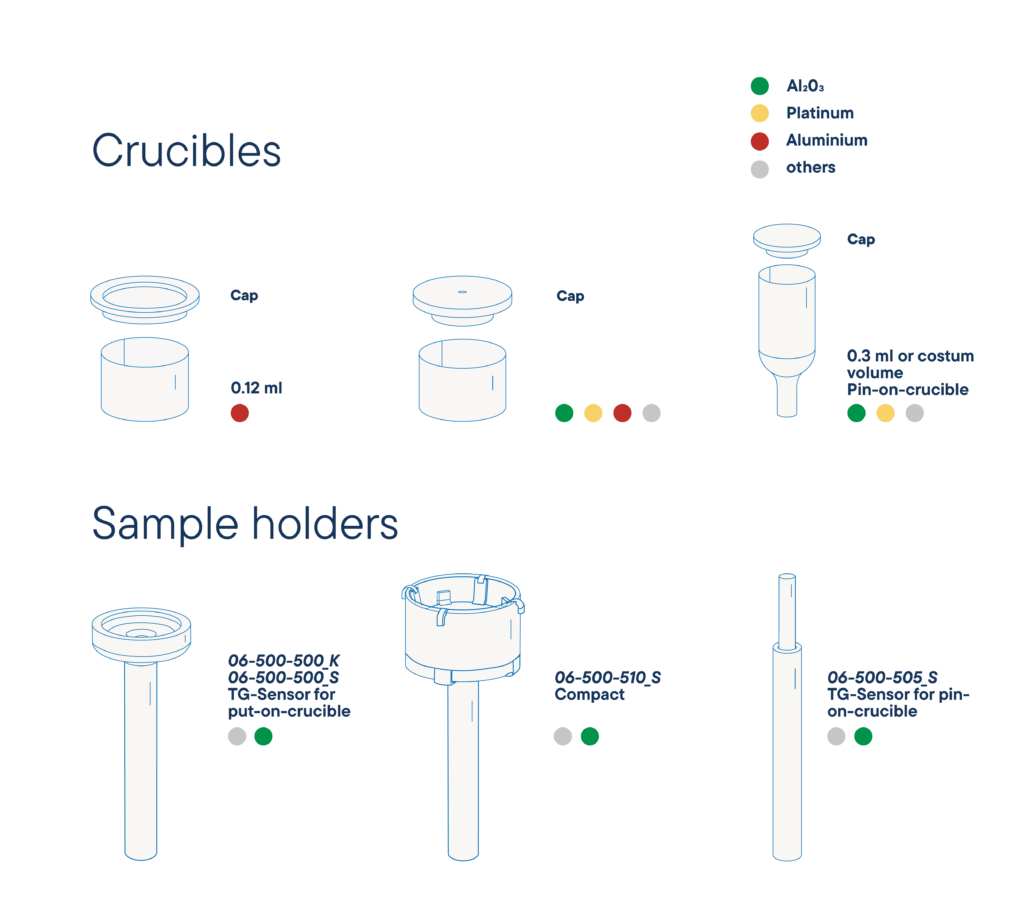
How much does an TGA L83 cost?
The price of an TGA L83 system depends on the selected configuration and additional options, such as the temperature range, furnace type, cooling system, automation features, or specialized measurement modes. Since each system can be tailored to your specific application requirements, the cost can vary significantly.
For an exact quotation, please use our contact form to send us your requirements – we will be happy to prepare a customized offer for you.
What is the delivery time for an TGA L83?
The delivery time for an TGA L83 largely depends on the chosen options and configuration. Additional features such as special furnaces, extended temperature ranges, automation, or custom adaptations may increase production and preparation time and therefore extend the delivery period.
Please contact us via our contact form to receive an accurate delivery time estimate based on your individual requirements.
Can TGA systems perform pressure-dependent measurements?
Yes, with the appropriate configuration, the TGA L83 can also perform pressure-dependent measurements. Special high-pressure furnaces and gas control systems are available, allowing operation under elevated pressure. This is particularly useful for simulating reactions under realistic process conditions, for example in materials research, catalyst development, or safety testing.
Please contact us to discuss the suitable equipment and pressure ranges for your application.
Are measurements under hydrogen and water vapor atmospheres possible with TGA systems?
Yes, the TGA L83 can – with the corresponding equipment – be operated under both hydrogen and water vapor atmospheres. For hydrogen measurements, special safety-certified gas systems and high-temperature furnaces are available to ensure safe and controlled operation. Water vapor atmospheres can be generated using dedicated humidification systems and heated gas lines to prevent condensation and ensure stable measurement conditions.
These capabilities are particularly valuable for applications in materials development, corrosion studies, catalysis, and energy technology.
Can TGA systems be coupled with gas analyzers, and is in-situ gas analysis possible?
Yes, the TGA L83 can be coupled with various gas analyzers such as FTIR, MS, or GC systems. This allows in-situ analysis of gases released during the measurement. The coupling is carried out via heated transfer lines, ensuring condensation-free gas transport and accurate correlation of thermal events with the gas composition.
This combination offers a significant advantage as it provides information not only on the thermal and mass-related changes of the sample but also on the nature of the gases formed or released – ideal for material characterization, decomposition studies, and reaction mechanism analysis.
Software
Making values visible and comparable
All LINSEIS thermoanalytical devices are software-controlled. The individual software modules run exclusively under Microsoft® Windows® operating systems. The complete software consists of 3 modules: temperature control, data acquisition and data evaluation. The Windows® software contains all the essential functions for preparing, carrying out and evaluating a thermoanalytical measurement. Thanks to our specialists and application experts, LINSEIS was able to develop a comprehensive, easy-to-understand and user-friendly software.

Features software
- Program suitable for text editing
- Data backup in the event of a power failure
- Thermocouple breakage protection
- Repeat measurements with minimal
parameter input - Evaluation of the current measurement
- Curve comparison up to 50 curves
- Saving and exporting evaluations
- Export and import of ASCII data
- Data export to MS Excel
- Multi-method analysis (DSC, TGA, TMA, DIL, etc.)
- Zoom function
- 1 and 2 Derivation
- Curve arithmetic
- Statistical evaluation package
- Automatic calibration
- Optional kinetics and service life prediction
- Software packages
TG features:
- Mass change in % and mg
- Rate-controlled mass loss (RCML)
- Evaluation of the mass loss
- Residual mass evaluation
- “Notes on dynamic TGA measurement” (optional, chargeable service)
LINSEIS Thermal Library
The LINSEIS Thermal Library software package is an option for the well-known, user-friendly LINSEIS Platinum evaluation software, which is integrated in almost all our devices. The Thermal Library allows you to compare the complete curves with a database containing thousands of references and standard materials in just 1-2 seconds.
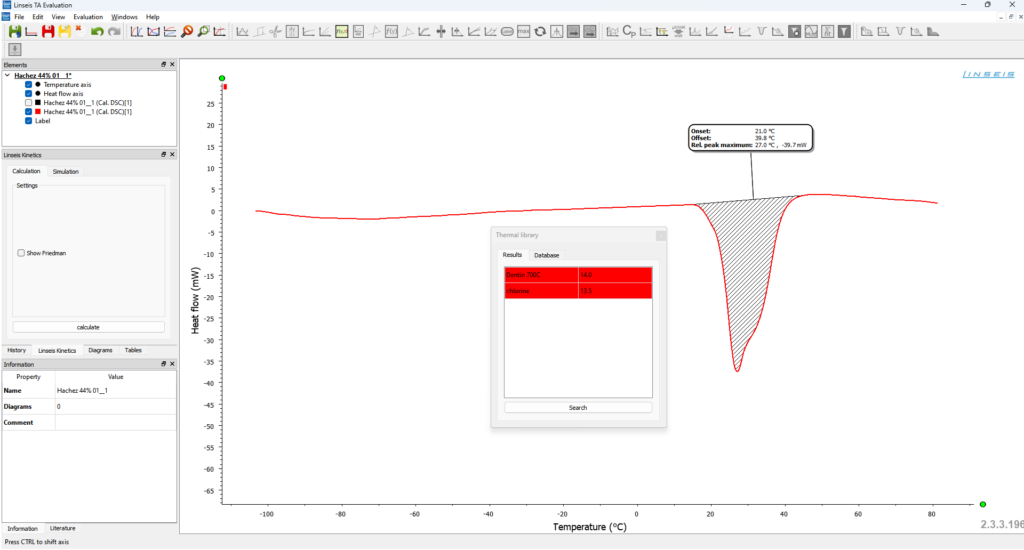
Multi-instrument
All LINSEIS instruments TGA, DSC, DIL, STA, HFM, LFA, etc. can be controlled via a software template.
Multilingual
Our software is available in many different user-interchangeable languages, such as: English, Spanish, French, German, Chinese, Korean, Japanese, etc.
Report generator
Convenient template selection for creating individual measurement reports.
Multi-user
The administrator can set up different user levels with different rights to operate the device. An optional log file is also available.
Kinetic software
Kinetic analysis of DTA, TGA, EGA (TG-MS, TG-FTIR) data to investigate the thermal behavior of raw materials and products.
Database
The state-of-the-art database enables simple data management with up to 1000 data records.
Applications
Automotive and aerospace industry
Thermogravimetric analysis (TGA) is an essential technique in research and development for the transportation and aerospace industries – including automotive engineering, aviation, satellite technology and manned space missions.
It provides valuable insights into material composition, thermal stability, and degradation behavior, supporting key processes such as component testing, quality assurance, process optimization, and failure analysis.
During operation, components are exposed to extreme temperature variations, oxidative environments and mechanical stress, all of which can influence material performance and lifespan.
By continuously monitoring mass changes during heating or cooling, TGA enables the precise characterization of decomposition, oxidation and evaporation processes in materials such as rubber, polymers, composites, coatings and lightweight alloys.
This data helps engineers to evaluate aging resistance, thermal durability and chemical stability — crucial factors for ensuring the safety and reliability of advanced transportation and aerospace systems.

Application example: Decomposition of rubber
The measurement of an industrial rubber sample was conducted using a simultaneous thermal analyzer (STA L82) in a nitrogen atmosphere. The sample was heated in three steps at a rate of 30 K/min each. The blue curve shows the relative weight loss. In the first step, dehydration of the sample occurs, releasing 9.3% water, with no effect observed on the corresponding DTA signal (dark red curve).
In the second reaction step, volatile components (36.0%) are released by pyrolysis under nitrogen, identified by an exothermic peak on the DTA curve. In the third step, the atmosphere changes to oxygen, leading to the combustion of the remaining carbon, resulting in a 14.3% weight loss. The remaining 40.4% consists of inorganic components like ash, lime, or fillers.
Building materials
Thermogravimetric Analysis (TGA) provides an effective method for characterizing building materials such as concrete, cement, mortar, gypsum, and other mineral compounds.
It enables the detailed investigation of composition, binder degradation, decomposition behavior, cement hydration, and other thermally induced reactions.
During a controlled heating program, the LINSEIS TGA L83 continuously measures changes in sample mass, allowing precise detection of moisture release, oxidation, carbonation, or decomposition processes.
This information reveals valuable insights into material stability, reaction mechanisms, and component ratios.
By analyzing these mass changes under defined atmospheres and heating rates, TGA provides a reliable and efficient tool for evaluating the thermal behavior and durability of modern construction and composite materials.
Application example: Gypsum plaster decomposition
The measurement example below shows a damage analysis of a gypsum plaster that showed cracks and structural damage after a summer – winter cycle. The manufacturer assumed that the application was not performed properly and used thermogravimetric analysis (TGA) to compare the damaged wall part with a reference gypsum sample that did not show cracks after heating and cooling cycles. The measurement shows that the carbon and organic content of the “bad” samples (green and blue curves) is almost identical with the reference samples (red and black curve).
The weight loss percentage shows the same level around 2 % mass loss in the range around 500 °C. However, there is a significant difference in the weight loss step around 800 °C – 900°C, where the contained carbonates are released as carbon dioxide: The reference samples show a mass loss of around 30 % caused by released CO2 while the samples from the wall with cracks show only 11 % mass loss and 13 % mass loss here. This indicates that the gypsum at the wall that showed structural failures has a significant lower carbon content than it should have which indicates that indeed the mixing of the gypsum plaster was performed wrong. Interestingly, there is also a difference in carbon content between the wall at the west side (weather facing side) and the east side of the building.
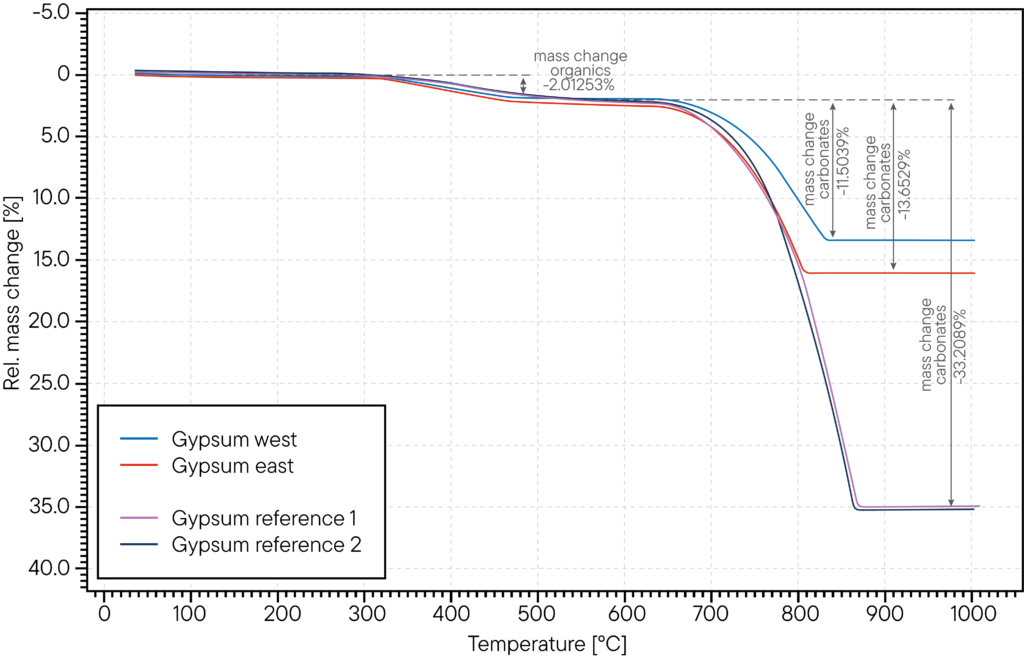
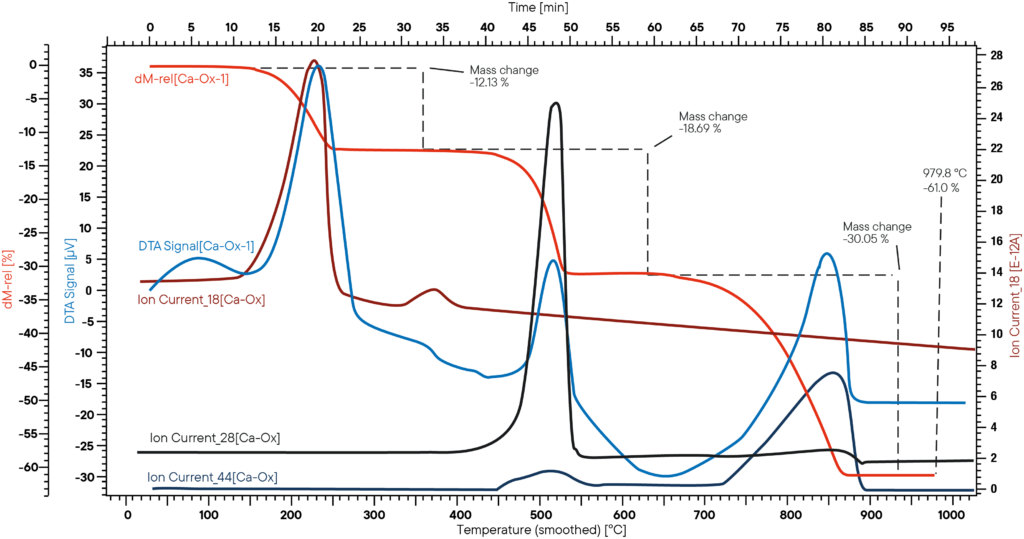
Application example: Decomposition of CaC2O4 • H2O
The curves on the left show a calcium oxalate reference run. On the blue and red curves (relative and absolute Δm), three mass loss steps are visible: the first step corresponds to the release of H₂O, the second to the loss of CO, and the third to the loss of CO₂. The resulting calcium oxide (CaO) subsequently reacts with the water from the first step, which remains in the reaction chamber if the atmosphere is static. This reaction forms calcium hydroxide (Ca(OH)₂) during cooling at around 580 °C.
This final step is difficult to observe with a standard TGA due to typically slow cooling rates. However, in this case, a full measurement cycle was completed 20 minutes. The heating and cooling rates were 2 K/s but can easily be increased to up to 100 K/s using an inductive TGA.
Application example: Cement
The measurement on the left was carried out with a TG-DSC. The main parts of cement are tri-calcium silicate, di-calcium silicate and tri-calcium aluminates.
After mixing the raw cement with water, different hydrates slowly form. When put in a STA, the absorbed water evaporates first during thermal decomposition, then hydrates of the calcium silicate decompose and at 570 °C the hydroxides of calcium, magnesium and aluminum follow.
You can see this effect as mass loss steps (red curve) with parallel endothermic effects on the DSC signal (blue curve). Subsequently, carbon dioxide is released from the carbonates, showing a huge mass loss step at around 800 °C.
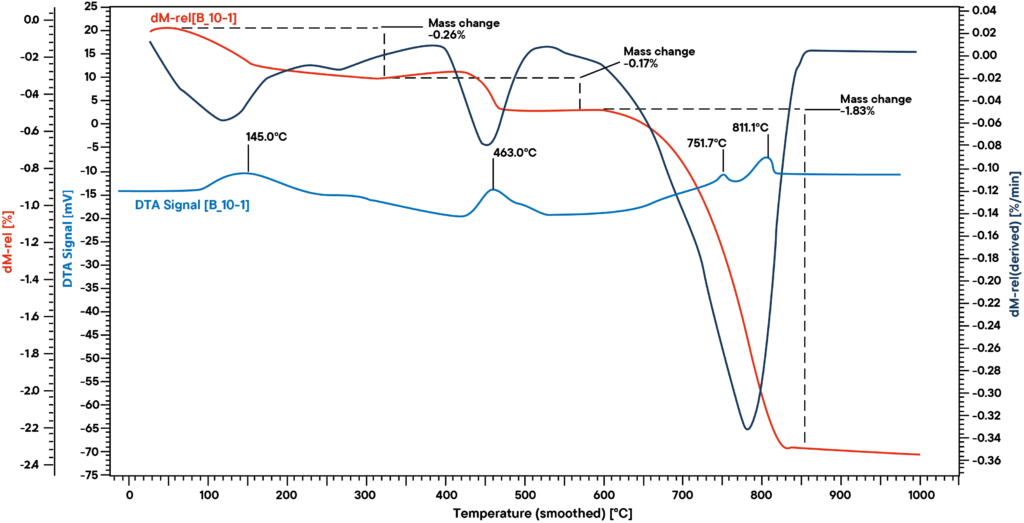
Cosmetics, Pharmaceuticals and Food
Metals used in industrial applications must fulfill specific properties resulting from their intended function. Characteristics such as hardness, mechanical strength, thermal expansion, thermal conductivity and resistance to oxidation and corrosion must be tailored to the conditions of use in order to ensure a long service life and reliability.
As pure metals often do not meet these requirements, they are usually alloyed with other elements – metals, semi-metals or non-metals. These combinations, known as alloys, have improved material properties and enable a wide range of technical applications.
Thermophysical measurement methods enable the analysis of important material behaviour such as phase transitions, crystallization temperatures, changes of state and the thermal stability of raw materials used in sheet metal, substrates or other metallurgical products. Other measurable parameters are the specific heat capacity, the linear thermal expansion and the melting point.
Application example: Aspirin
In this application acetylsalycylic acid (Aspirin) was measured by STA L82 with focus on the DSC-signal. By DSC, decomposition reactions can be observed and substances such as pharmaceuticals compounds can be investigated and identified. The measured ASS sample shows the following effects: At the beginning of the heating process, some adsorbed water is released, resulting in a weight loss of about 1 %. At 140°C the melting point of the aspirin is reached, resulting in an endothermic reaction, measured on the DTA trace. At 60°C, decomposition of the molten drug takes place in several stages.
The decomposition products are volatile, resulting in a total weight loss of almost 100 %.

Well informed
